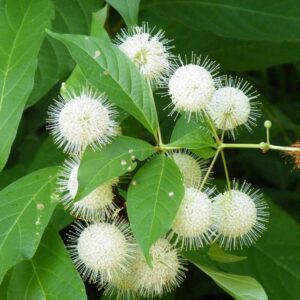Showing the single result
Wholesale Buttonbush Shrubs
The buttonbush shrub is a unique plant that grows the best in moist locations. You can typically find a buttonbush shrub thriving in a garden pond, riverbank, swamp, or any other site that is consistently damp.
These gorgeous bushes bloom unique spherical flower heads that look similar to a pincushion. The white, fragrant flowers will begin to bloom towards the end of summer, and they appear very attractive to hummingbirds, butterflies, and other insects. Although you will commonly find white blooms, you can occasionally find blooms that appear more red or pink.
In the late summer, the blooms will eventually harden into a button like ball and persist throughout the winter. Surrounding the blooms, you can expect to find green foliage that will emerge in the late spring. The foliage color is typically a lighter green, but don’t be surprised to see some red accents in the ribs and veins.
About The Buttonbush
The buttonbush is known for the many alternative names that it goes by, including buttonwillow, pond dogwood, swamp wood, or buttonwood. The buttonbush is beneficial to its environment in many ways. For starters, it’s a great food source for geese, ducks, and other shorebirds.
Songbirds will also use the foliage of the buttonbush for nesting. In areas where there are buttonbush shrubs, you will typically notice songbirds, hummingbirds, and butterflies.
Where Can You Find the Buttonbush?
The buttonbush can flourish in Hardiness Zones 5 to 9. You can often find these bushes up north in New Brunswick, Nova Scotia, and Ontario. You may also find them south to Florida and west to Nebraska and Texas.
More commonly, they are scattered around the United States and can be found in other populations such as Arizona, New Mexico, southern California, and northern Mexico.
Growing a Buttonbush Shrub
The average buttonbush can grow anywhere between 5-12 ft tall and 4-8 ft wide. They enjoy direct sunlight, and they grow best in moist, neutral-acid, well-drained soils. Your buttonbush can still grow in some shaded areas; however, the best flowering will occur in direct sunlight.
It’s a fairly easy plant to maintain. In fact, it grows best when it’s left alone to grow naturally. The buttonbush is a fast-growing shrub, and it will spread to form thickets by suckering. Resulting in individual plants growing from the roots.
Used for Erosion Control
When planted along the shorelines, the buttonbush can be very helpful with erosion control. Because of its dense stand and its swollen base stabilizing the plant, this helps immensely with erosion control.
Benefits for Wildlife
Many wildlife animals enjoy consuming the seeds of the buttonbush. You may also occasionally see deer munching on the buttonbush’s foliage in the northeastern region of the United States. Many animals will also take advantage of the plant’s structure and use it as a place for protection and a place to nest.
It’s very common to see pollinators such as butterflies, bees, and hummingbirds engaging with the bush for its nectar. It even helps bees produce honey!
Ornamental Features and Landscape Use
Because of their blooming flowers and fruit, the buttonbush is a popular choice for use in native plant gardens, shrub borders, and along with your ponds and shores. This shrub prefers low-lying areas that aren’t expected to dry out until late in the season. Your buttonbush needs to be watered regularly, especially when placed in direct sunlight.
If your buttonbush becomes too large for your landscaping, trim it by cutting close to the base or crown. You’ll want to do this in the early spring before new growth begins to grow.
A cultivar is a plant produced in cultivation by selective breeding or through vegetative propagation from wild plants that appear to have more desirable traits.
Here are some of the following cultivars:
Bailoptics Also commonly referred to as Fiber Optics, this plant can grow about 5 to 6 feet high and wide. It’s a great plant for lower areas in landscaping. It requires full sun exposure, medium to high watering, and pruning beginning in the early spring.
Bieberich Originally found in Oklahoma, this cultivar can grow anywhere between 10 to 15 feet high and 10 to 12 feet wide. The rounded pale pink flowers will stand out when in bloom, and their bright glossy green leaves will fade to a gorgeous coppery-bronze in the fall.
Keystone Known for its dense shoots and leaves, the keystone cultivar can grow 8 to 12 feet high and 5 to 8 feet wide. It was introduced in 1996 it was released for use in wetland and riparian area restoration for the entire common buttonbush range.
SMCOSS USSP 26, 543 More commonly known as the Sugar Shack, this dwarf cultivar only grows about 3 to 4 feet high and wide. This buttonbush grows red fruit with reddish tipped foliage.
Wholesale Buttonbush Shrubs For Sale in Michigan
Contact Cold Stream Farm today to learn about the Buttonbush Shrubs we sell in Michigan. If you have any questions, we are a wholesale/retail bare root tree and shrub nursery in Michigan and would be happy to answer your questions!


